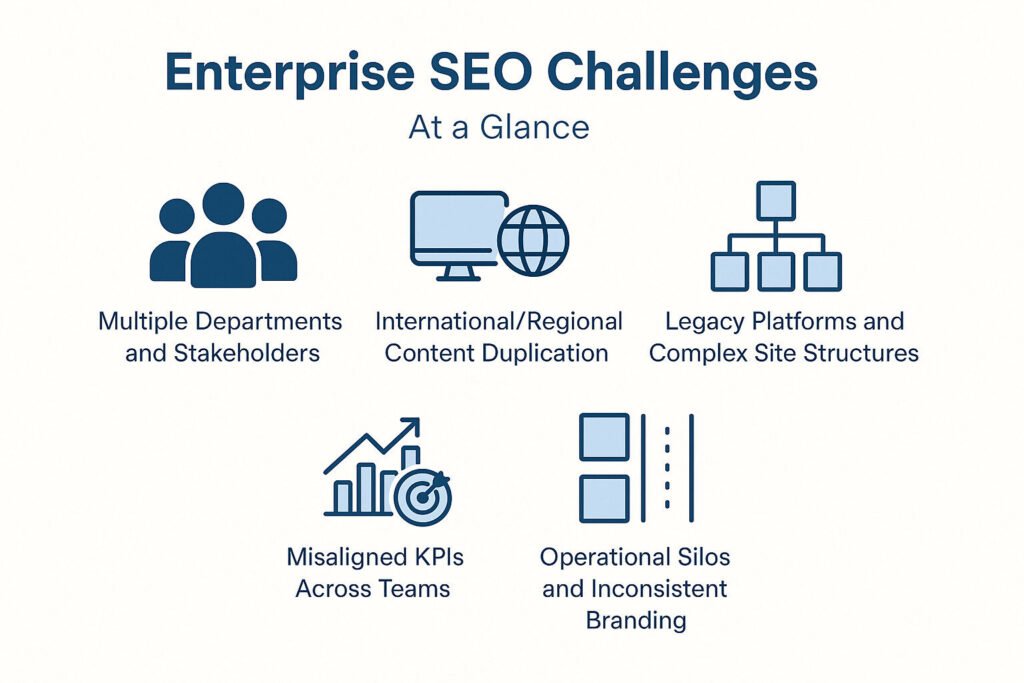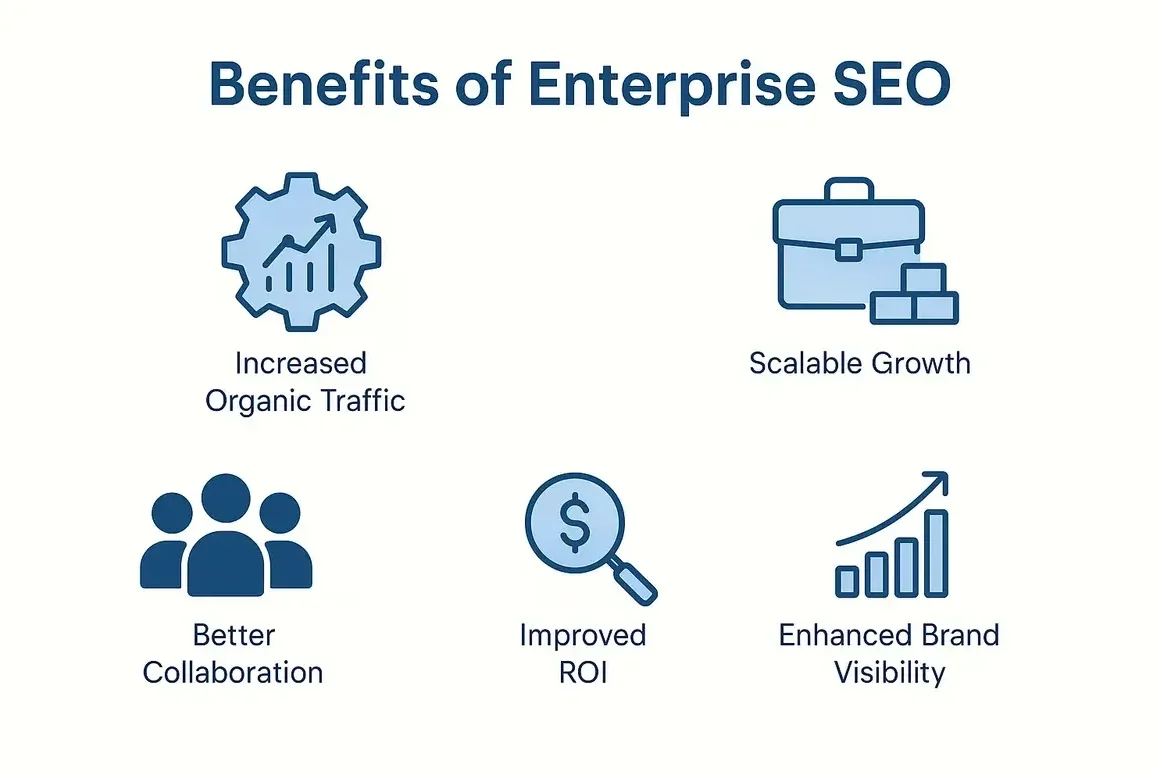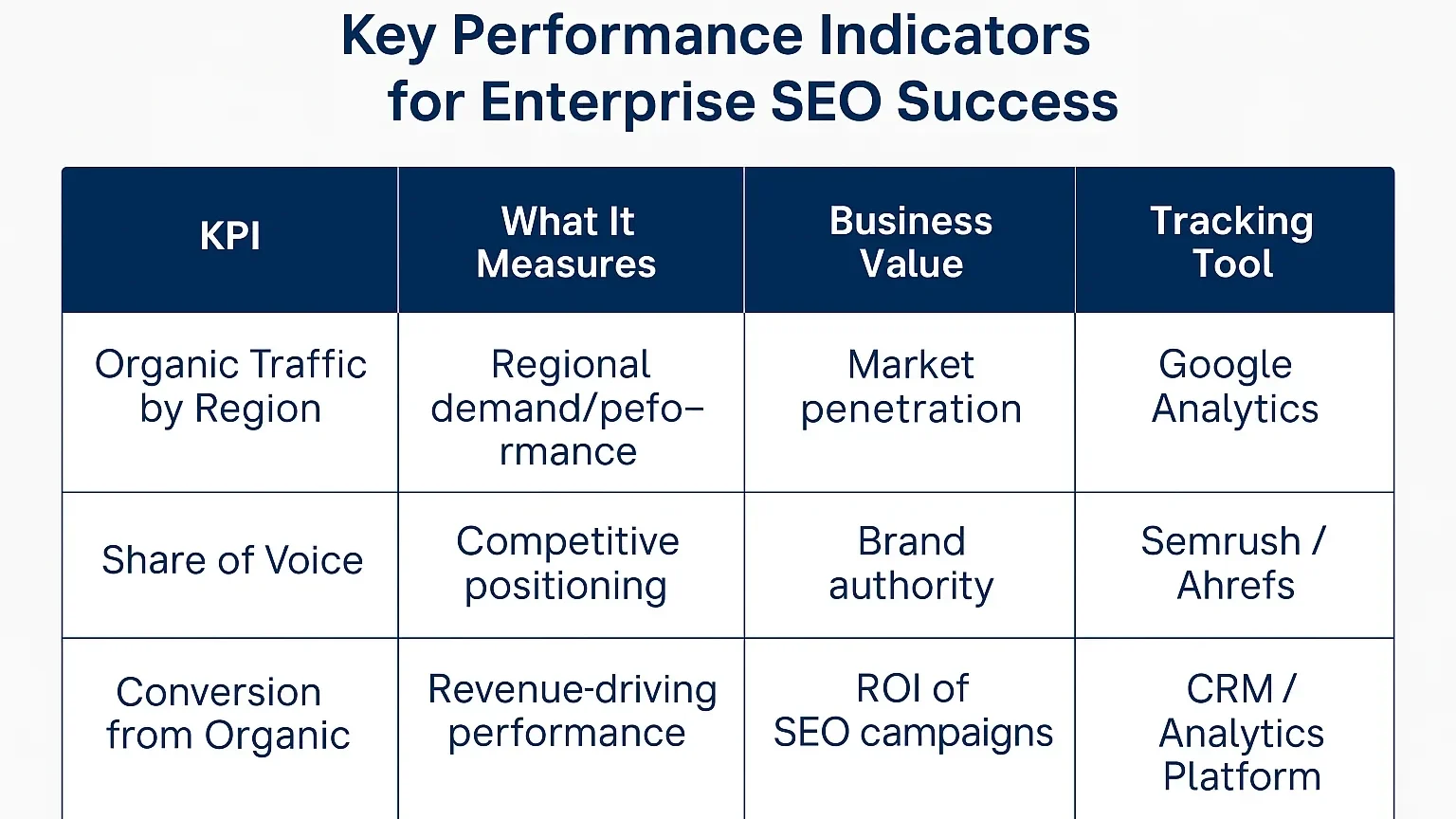Disclaimer: The information provided in this article is for general informational purposes only and does not constitute professional advice. Business strategies and SEO practices may vary depending on individual circumstances. Always consult with qualified professionals before making decisions that could impact your organization’s financial or operational performance.
Why Large Organizations Face Unique SEO Challenges

Tackling SEO at an enterprise level brings a unique set of hurdles that don’t exist in smaller environments. Coordination can quickly become overwhelming with dozens or even hundreds of stakeholders, multiple departments, and sometimes international branches. Each group may have its goals, editorial calendars, and KPIs, often resulting in siloed operations that miss the benefits of a strong, unified search presence. For example, inconsistencies in brand messaging or duplicated content across regional sites can hurt search visibility and reduce overall brand authority.
The complexity only increases with the technical aspects of enterprise sites, which often involve legacy platforms, intricate navigational structures, and custom integrations. Unifying the efforts of marketing, IT, and content teams is not just ideal, it’s essential. Bringing in expertise such as what’s available through enterprise seo services helps organizations identify technical gaps, overcome operational silos, and create a blueprint that’s easy for every department to follow. This focus on structure and process sets the groundwork for measurable, scalable success across regions and product lines. Collaboration becomes more efficient and consistent when every team understands its role in the SEO ecosystem. This alignment boosts search visibility and establishes digital strategies to support long-term business goals.
Scalability: The Backbone of Successful Corporate SEO

Effective SEO for large organizations must scale effortlessly across thousands of web pages, several business units, and diverse audiences. Manual optimization is not feasible at this scale. Instead, organizations should lean on automation to power frequent audits, discover issues before they become widespread, and standardize best practices throughout sprawling site architectures. Automated site crawlers, bulk metadata editors, and centralized workflow tools save tremendous manual labor. Moreover, programmatic solutions allow companies to dynamically update critical SEO elements such as title tags, structured data, and internal linking at scale.
- Automated audits highlight technical SEO errors and send alerts before visibility drops.
- Bulk tooling reduces the time required to update key meta information on large sites.
- Consistent use of structured data establishes straightforward content to users and search engines.
According to recent coverage on SEO scalability, scalable approaches are crucial for expanding reach and minimizing errors. In large organizations, automation doesn’t replace human expertise but frees up strategists to focus on growth, innovation, and adapting to algorithm changes.
Data-Driven Decision-Making in Big SEO Campaigns
The ability to turn vast troves of performance data into actionable insights separates strong enterprise SEO from the rest. Enterprise organizations often deploy a wide array of tools: advanced analytics platforms, market research modules, heatmaps, UX analytics, and conversion optimization suites. The challenge and opportunity come in consolidating this information into a single source of truth, where leaders can spot trends and take swift, informed action. This kind of data visibility empowers enterprises to refine keyword strategies, spot emerging trends, and identify underperforming areas that need improvement.
Research continually shows that organizations making data-driven decisions quickly outpace those using guesswork. For example, industry feedback indicates that over 80% of marketing teams in large firms consider integrated data the key to successful SEO. Dashboards that synthesize analytics from Google Analytics, Google Search Console, and custom platforms fuel smarter optimizations and encourage objective, metrics-driven conversations, rather than relying solely on gut feelings or outdated assumptions. This level of intelligence helps resolve internal debates and guides strategy toward high-impact work.
Integrating SEO Across Multiple Teams
SEO touches nearly every part of today’s enterprise content, design, development, merchandising, and customer support. Yet, without a culture of collaboration, even the most robust strategies can fall short in execution. Integration begins with fostering open communication and knowledge sharing. Organizations often benefit from designating SEO liaisons within each department, who act as educators and enforcers of SEO best practices.
Practical Ways to Improve Collaboration
- Host regular standups to update teams on changes in search trends, new guidelines, or major wins.
- Offer training sessions and knowledge base materials to help non-SEO colleagues understand core concepts.
- Celebrate cross-team wins and innovations to reinforce the value of collaboration.
Consider the example of launching a global product. Early involvement from SEO strategists and project managers in every facet, from page structure to international targeting tags, is set up for maximum visibility and engagement. With an integrated approach, companies avoid costly missteps like missing Hreflang tags or fragmented user journeys, instead delivering a unified experience to customers and search engines alike.
Technology and Algorithm Updates: Staying Ahead
| Year | Major Google Update | Impact on Enterprise SEO | Recommended Action |
|---|---|---|---|
| 2023 | Helpful Content Update | Prioritized user-focused content | Improve content quality |
| 2024 | Core Web Vitals Expansion | UX & mobile speed became critical | Optimize performance metrics |
| 2025 | AI Search Integration | Shift toward conversational queries | Expand to long-tail + semantic SEO |
The pace of change in search engine algorithms and the rise of AI-driven features mean enterprises can’t afford complacency. Today’s ranking factors are more nuanced than ever, incorporating user engagement metrics, mobile usability, page speed, and even the depth of topical coverage. Search engines frequently release major updates that can cause significant shifts in organic visibility, sometimes overnight.
- Monitor official algorithm updates regularly and adapt processes accordingly.
- Build staging environments to test SEO changes before global rollouts, reducing the risk of unforeseen dips.
- Schedule ongoing audits for emerging factors like Core Web Vitals and accessibility.
Maintaining a leadership position means testing, learning, and adapting faster than competitors. Corporate SEO teams gain a critical competitive edge by reallocating resources in anticipation of algorithmic changes and not simply reacting. Leaders in this space see algorithm updates as opportunities for growth, not just threats to manage.
Measuring Success: Metrics That Matter Most

Demonstrating SEO’s impact can be challenging in a large organization, where revenue attribution is often split across channels and regions. Instead of focusing only on keyword rankings, successful teams tie SEO success directly to business outcomes, organic conversions, inbound leads, and engagement with high-value pages. These KPIs resonate with stakeholders far more than charts alone.
- Organic search traffic volume and quality, segmented by product, region, or buyer intent.
- Share of voice metrics, benchmarking content visibility against top industry rivals.
- Growth in authoritative backlinks and overall domain strength.
- Advancements in core performance metrics, including site load speed and mobile usability.
The most effective enterprise SEO initiatives build regular, transparent reporting into their workflows. Real-time dashboards and executive summaries make it easy for teams and leadership to see progress, spot trends, and make timely decisions. This level of visibility, especially when paired with continuous feedback loops, drives measurable ROI and sustained organizational support.
Embracing Change and Continuous Learning
SEO is a moving target. What propelled a website to the top of last year’s rankings might be less relevant today. For large organizations with extensive content portfolios and legacy systems, adapting quickly is necessary and a strategic advantage. Successful enterprises invest in team development, encourage workshop attendance, support certifications, and share the latest trends from major industry events.
Another critical component is embracing experimentation. This means testing new technologies, piloting small-scale initiatives, and learning from failures. When team members have space to explore new formats such as video SEO, schema markups, or optimizing for voice search, they’re better equipped to capture emerging opportunities before they hit the mainstream. Organizations prioritizing adaptability remain market leaders, regardless of how algorithms or user expectations shift.











